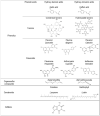Clinical Evidence of the Benefits of Phytonutrients in Human Healthcare
- PMID: 35565680
- PMCID: PMC9102588
- DOI: 10.3390/nu14091712
Clinical Evidence of the Benefits of Phytonutrients in Human Healthcare
Abstract
Phytonutrients comprise many different chemicals, including carotenoids, indoles, glucosinolates, organosulfur compounds, phytosterols, polyphenols, and saponins. This review focuses on the human healthcare benefits of seven phytochemical families and highlights the significant potential contribution of phytonutrients in the prevention and management of pathologies and symptoms in the field of family health. The structure and function of these phytochemical families and their dietary sources are presented, along with an overview of their potential activities across different health and therapeutic targets. This evaluation has enabled complementary effects of the different families of phytonutrients in the same area of health to be recognized.
Keywords: anthocyanins; caffeine; carotenoids; flavonoids; healthcare; organosulfur compounds; phenolic acids; phytonutrients; tannins.
Conflict of interest statement
M.J. Amiot, J. Fleurentin and J.M. Morel have acted as consultants for, and as expert witnesses on behalf of, Pierre Fabre Laboratories, France. N. Monjotin and S. Raynal are employees of Pierre Fabre Laboratories, France.
Figures
Similar articles
-
Representative literature on the phytonutrients category: Phenolic acids.Crit Rev Food Sci Nutr. 2017 Apr 13;57(6):1089-1096. doi: 10.1080/10408398.2013.865589. Crit Rev Food Sci Nutr. 2017. PMID: 25831057 Review.
-
Intake Estimation of Phytochemicals in a French Well-Balanced Diet.Nutrients. 2021 Oct 16;13(10):3628. doi: 10.3390/nu13103628. Nutrients. 2021. PMID: 34684628 Free PMC article.
-
Phytochemicals in Cancer Treatment and Cancer Prevention-Review on Epidemiological Data and Clinical Trials.Nutrients. 2023 Apr 14;15(8):1896. doi: 10.3390/nu15081896. Nutrients. 2023. PMID: 37111115 Free PMC article. Review.
-
Phytonutrients as therapeutic agents.J Complement Integr Med. 2014 Sep;11(3):151-69. doi: 10.1515/jcim-2013-0021. J Complement Integr Med. 2014. PMID: 25051278 Review.
-
The phytochemical composition and antioxidant actions of tree nuts.Asia Pac J Clin Nutr. 2010;19(1):117-23. Asia Pac J Clin Nutr. 2010. PMID: 20199996 Free PMC article. Review.
Cited by
-
Wild edible yams from Madagascar: New insights into nutritional composition support their use for food security and conservation.Food Sci Nutr. 2023 Oct 16;12(1):280-291. doi: 10.1002/fsn3.3757. eCollection 2024 Jan. Food Sci Nutr. 2023. PMID: 38268876 Free PMC article.
-
Caffeine causes cell cycle arrest at G0/G1 and increases of ubiquitinated proteins, ATP and mitochondrial membrane potential in renal cells.Comput Struct Biotechnol J. 2023 Sep 21;21:4552-4566. doi: 10.1016/j.csbj.2023.09.023. eCollection 2023. Comput Struct Biotechnol J. 2023. PMID: 37799542 Free PMC article.
-
Development of a Guava Jelly Drink with Potential Antioxidant, Anti-Inflammation, Neurotransmitter, and Gut Microbiota Benefits.Foods. 2025 Jul 7;14(13):2401. doi: 10.3390/foods14132401. Foods. 2025. PMID: 40647153 Free PMC article.
-
Bioactive Natural and Synthetic Products in Human Health and Diseases: Basic, Preclinical and Clinical Studies.Nutrients. 2024 Sep 27;16(19):3265. doi: 10.3390/nu16193265. Nutrients. 2024. PMID: 39408232 Free PMC article.
-
Editorial: Regulatory T lymphocytes in cancer immunity.Front Immunol. 2022 Oct 24;13:1065570. doi: 10.3389/fimmu.2022.1065570. eCollection 2022. Front Immunol. 2022. PMID: 36353629 Free PMC article. No abstract available.
References
-
- Poiroux-Gonord F., Bidel L.P., Fanciullino A.L., Gautier H., Lauri-Lopez F., Urban L. Health benefits of vitamins and secondary metabolites of fruits and vegetables and prospects to increase their concentrations by agronomic approaches. J. Agric. Food Chem. 2010;58:12065–12082. doi: 10.1021/jf1037745. - DOI - PubMed
Publication types
MeSH terms
Substances
LinkOut - more resources
Full Text Sources




